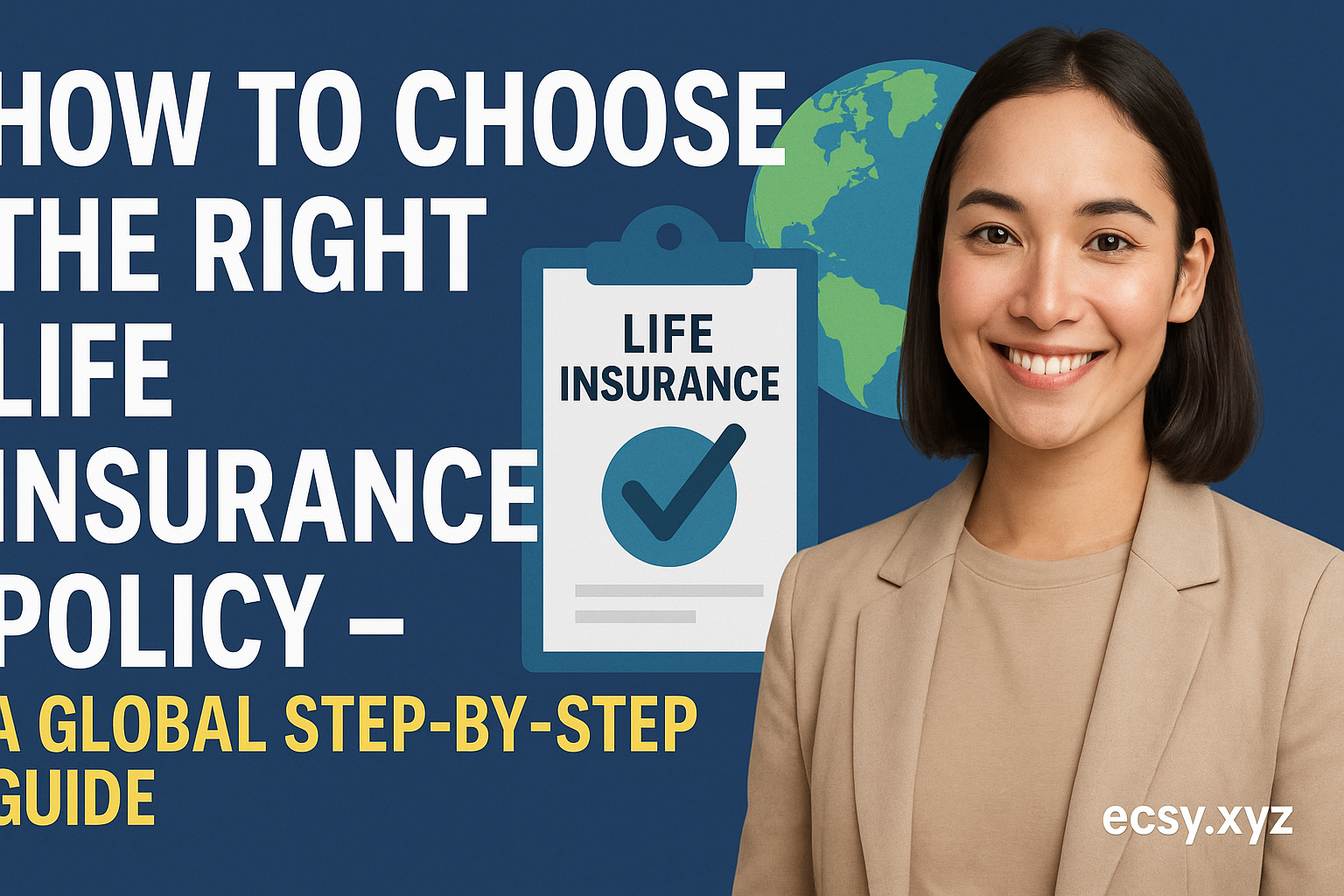Let’s face it—choosing a life insurance policy can feel like trying to read a foreign language with no translator. Whether you’re in the US, India, Germany, or anywhere else, life insurance is essential to protect your loved ones and give yourself peace of mind. This guide simplifies the process, breaking down every step to help you choose the right policy no matter where you are in the world.
Understanding the Basics of Life Insurance
What is life insurance?
In simple terms, life insurance is a contract between you and an insurer. You pay premiums, and in return, the insurer pays your beneficiaries a sum of money when you pass away. It’s financial protection for your family when you’re no longer around.
Types of life insurance
There are several types, and knowing the difference matters big time.
Term Life Insurance
This covers you for a specific period (like 10, 20, or 30 years). If you die during that time, your beneficiaries get the payout. It’s affordable and straightforward.
Whole Life Insurance
Covers you for your entire life. Plus, it builds a cash value you can borrow against. But it’s pricier.
Universal Life Insurance
Offers flexible premiums and death benefits. It also has a cash value component that earns interest.
Variable Life Insurance
This is for the financially savvy—it includes investment options. Your cash value and death benefit can grow, but also shrink, based on market performance.

Determine Your Life Insurance Needs
Before buying anything, ask: Why do I need this?
Financial Obligations
Think about your mortgage, car loan, or other debts. You don’t want your family stuck paying them off.
Dependents’ Needs
Do you have kids? A spouse who depends on your income? Calculate how much they’d need to stay afloat.
Debts and Final Expenses
Funeral costs can be expensive. Make sure they’re covered.
Lifestyle and Long-Term Goals
Want to leave behind a college fund? Or a cushion for retirement? Factor those into your policy amount.
Choosing Between Term and Permanent Life Insurance
Term life is best if you’re young, healthy, and want cheap coverage. Permanent life is good if you want lifelong protection and investment value.
Think of term like renting an apartment—cheaper short term. Permanent is like buying a house—costly but builds value.
Consider Your Age and Health
The younger and healthier you are, the cheaper your premiums. But don’t worry—even if you’re older or have health issues, options exist.
Some policies don’t require medical exams (called “no-exam life insurance”), but they may cost more.
Set a Budget
Let’s be real—you need to afford the policy you choose.
-
Don’t overspend just to get a higher death benefit.
-
Avoid hidden charges like admin fees or surrender costs.
-
Use the 10x Rule: Get coverage equal to 10x your annual income.
Research Insurance Providers
Company Reputation
Look for reviews and ratings on global sites like Trustpilot or local platforms.
Financial Strength
Check ratings from A.M. Best, Moody’s, or S&P. You want a company that can actually pay out.
Customer Service Ratings
Read real user experiences. Fast and smooth claims are a big deal.
Compare Life Insurance Quotes
Don’t grab the first offer you get.
Use comparison tools online. Or better yet, talk to an agent who can pull quotes from multiple companies in your country or globally.
Understanding Policy Terms and Conditions
Don’t skip the fine print—it’s where surprises hide.
-
Look for terms like “exclusions,” “waiting periods,” and “premium escalation.”
-
Make sure you understand how and when benefits are paid.
The Role of Riders and Add-ons
What Are Riders?
Think of riders as extra toppings on your pizza—added benefits for a bit more cost.
Useful Riders to Consider
-
Critical illness rider
-
Accidental death rider
-
Waiver of premium rider
-
Child education rider
These can enhance your coverage big time.
Review the Claim Settlement Ratio
A high claim settlement ratio means the company pays out most claims—important!
You’ll find these stats on insurer websites or government insurance regulators.
Local Laws and Tax Implications
Depending on your country, life insurance could come with tax benefits.
-
In the U.S., payouts are usually tax-free.
-
In India, premiums and benefits can get tax deductions under sections like 80C and 10(10D).
-
In Europe, benefits vary—consult a local expert.
Getting Professional Help
Insurance can get complicated fast. Hiring a licensed financial advisor or insurance broker could save you a lot of stress.
Ask them:
-
Are you independent or tied to one company?
-
What’s your commission structure?
-
Can you show options from multiple insurers?
Buying Life Insurance Online vs. Offline
Online is fast, convenient, and often cheaper.
Offline (through an agent) gives you personal advice and assistance. Choose what fits your comfort level—but always verify credentials.
Reviewing and Updating Your Policy
Your life changes. Your policy should too.
Update your policy if you:
-
Get married/divorced
-
Have a child
-
Buy property
-
Change jobs
Set an annual reminder to review it.
Common Mistakes to Avoid
-
Don’t buy too little or too much.
-
Don’t forget to name (and update) your beneficiaries.
-
Don’t ignore exclusions or policy lapses.
-
Don’t delay—waiting increases costs.
Conclusion
Choosing the right life insurance policy isn’t just about ticking boxes. It’s about securing your loved ones’ future, on your terms. Whether you’re 25 or 55, living in the U.S., India, Canada, or Germany—the steps remain the same. Take your time, ask the right questions, and get a policy that truly fits your life. Because peace of mind is priceless.
FAQs
1. What is the best type of life insurance for young adults?
Term life insurance is usually best—it’s affordable and covers essential needs during early adulthood.
2. How much coverage do I really need?
A good rule of thumb is 10–15x your annual income. Factor in debts, expenses, and future goals.
3. Can I have multiple life insurance policies?
Yes, as long as your total coverage makes sense based on your income and needs.
4. What happens if I miss a premium payment?
You may get a grace period (usually 30 days). If not paid, the policy could lapse. Some policies have an automatic loan feature to cover premiums.
5. Is life insurance taxable?
In most countries, the death benefit is tax-free. But policies with investment components may have some tax implications. Always check your local laws.

